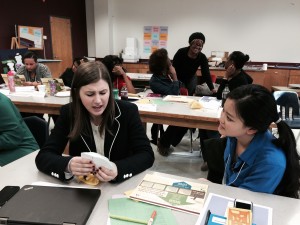State Team Roles

The STEM Equity Pipeline project is a collaborative effort between State Teams and an Extension Services Group of leading researchers and practitioners in gender equity and STEM education. The project’s success relies on the commitment of the members of the invited State Team, the involvement of the Network, and the project staff in implementing the activities of this NSF-funded project. Participating states have multiple layers of involvement as described below.
The State Contact(s) will
- Participate in regular conference calls to plan the state’s work.
- Identify members of the State Leadership Team.
- Use collaboration software to share documents, manage a state project calendar, and communicate with the State Leadership Team members.
State Leadership Team members will
- Use collaboration software to share documents, manage a state project calendar, and communicate with fellow State Leadership Team members.
- Read the monthly e-newsletter and other national email list communications and share with other professional development networks statewide.
- Work with the State Facilitator to develop the State Team annual work plan and identify members of the State Team.
- Invite individuals to participate on the State Team and in project activities.
- Conduct outreach to potential participants in the State Network.
- Assist the project evaluators in identifying potential data sources to conduct performance gap analyses of women and girls in STEM cluster programs of study.
- Identify and sponsor professional development events in the state, where presentations can be made on research-based strategies for increasing the participation of women and girls in STEM. Present at these events whenever possible using the information obtained through the project’s professional development activities.
- Conduct an inventory and assessment of professional development needs for teachers of STEM cluster programs of study, particularly as they relate to building the capacity of teachers to increase the participation and completion of women and girls in STEM cluster programs of study.
- Host the State Facilitator for quarterly onsite visits with the State Leadership Team to monitor work plan implementation and conduct Program Improvement Process for Equity training.
- Host an annual gathering of the State Team.
- Participate in the project-sponsored webcasts and webinars whenever possible.
- Participate in the annual State Team Leadership Training.
- Participate on the Virtual Learning Community by using sharing strategies, resources, models, and research that support the project’s goals.
- Incorporate the NAPE professional development into the professional development provided to teachers of STEM cluster programs of study.
- Cooperate with the project evaluator to assess the impact of the project’s activities on the participation of women and girls in STEM cluster programs of study and on teacher professional development efforts in the state.
State Team Members will
- Identify state data sources that project evaluators can use to conduct performance gap analyses of women and girls in STEM cluster programs of study within the state and to inform the project evaluation.
- Attend an annual gathering of the State Team.
- Provide feedback to the State Leadership Team on the development and implementation of the annual workplan.
- Identify professional development events in the state where presentations can be made on research-based strategies for increasing the participation of women and girls in STEM. Present at these events whenever possible using the information obtained through the project professional development activities.
- Register on the project website and receive the monthly e-newsletter and other national email list announcements.
- Participate in the project-sponsored webcasts and webinars whenever possible.
- Participate on the Virtual Learning Community by using and sharing strategies, resources, models, and research that support the project’s goals.
- Complete a survey of their professional development needs to increase their ability to provide professional development for teachers of STEM cluster programs of study, particularly as they relate to increasing the participation and completion of women and girls. These survey results will be used by the project to set the professional development agenda.
- Incorporate the NAPE professional development into the professional development provided to teachers of STEM cluster programs of study and other constituents.
- Complete evaluation instruments and surveys from the project evaluator to assess the impact of the project’s activities on their capacity to provide effective professional development on strategies for increasing the participation of women and girls in STEM cluster programs of study.
State Network Members will
- Register on the project website and receive the monthly e-newsletter and other national email list announcements.
- Participate in the project-sponsored webcasts and webinars whenever possible.
- Participate on the Virtual Learning Community by using and sharing strategies, resources, models, and research that support the project’s goals.
- Complete a survey of their professional development needs to increase their ability to provide professional development for teachers of STEM cluster programs of study, particularly as they relate to increasing the participation and completion of women and girls. These survey results will be used by the project to set the professional development agenda.
- Incorporate the NAPE professional development into the professional development provided to teachers of STEM cluster programs of study in their local school districts or community colleges.
- Complete evaluation instruments and surveys from the project evaluator to assess the impact of the project’s activities on their capacity to provide effective professional development on strategies for increasing the participation of women and girls in STEM cluster programs of study.
 This material is based upon work supported by the National Science Foundation under Grant No. HRD-0734056 and Grant No. HRD 1203121. Any opinions, findings, and conclusions or recommendations expressed in this material are those of the author(s) and do not necessarily reflect the views of the National Science Foundation.
This material is based upon work supported by the National Science Foundation under Grant No. HRD-0734056 and Grant No. HRD 1203121. Any opinions, findings, and conclusions or recommendations expressed in this material are those of the author(s) and do not necessarily reflect the views of the National Science Foundation.
